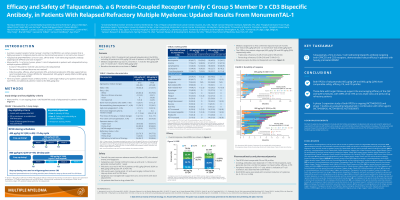Back

Industry Encore Posters
JL1009E: Efficacy and safety of talquetamab, a G protein-coupled receptor family C group 5 member D x CD3 bispecific antibody, in patients with relapsed/refractory multiple myeloma (RRMM): updated results from MonumenTAL-1
Saturday, October 22, 2022
10:00 AM – 11:00 AM ET


Patrick Stoy, PhD, BS
Senior Medical Science Liaison
Janssen Biotech, Inc
Poster Presenter(s)
Background:
G protein-coupled receptor family C group 5 member D (GPRC5D), which has limited expression in normal human tissue but is highly expressed on malignant plasma cells, is a promising target for multiple myeloma (MM) immunotherapy. Talquetamab (JNJ-64407564) is a first-in-class, bispecific IgG4 antibody that binds to both GPRC5D and CD3 receptors, mediating T-cell–activated lysis of GPRC5D+ MM cells. Here we report updated results with additional patients (pts) and longer follow-up from MonumenTAL-1, a phase 1 trial of talquetamab in RRMM (NCT03399799).
Methods:
Eligible pts had RRMM or were intolerant to standard therapies; prior B-cell maturation antigen-directed therapies were permitted. The primary objectives were to identify the recommended phase 2 doses (RP2Ds) (part 1) and assess talquetamab safety and tolerability at the RP2Ds (part 2). Collective safety, efficacy, PK, and PD data supported 2 RP2Ds for talquetamab: 405 μg/kg SC QW (n=30) and 800 μg/kg SC Q2W (n=44). Step-up dosing was used to mitigate against severe cytokine release syndrome (CRS); required premedications were limited to step-up doses and the first full dose of talquetamab. Adverse events (AEs) were graded by CTCAE v4.03 with CRS events graded per Lee et al 2014 criteria. Investigators assessed responses per International Myeloma Working Group criteria.
Results:
As of Jan 17, 2022, pts in the 405 μg/kg/800 μg/kg groups, respectively, received a median of 6 /5 prior lines of therapy, 100%/98% were triple-class (TC) exposed, 77%/75% were TC refractory. Median follow-up (range) was 11.7 (1.0–21.2)/4.2 (0.7–13.7) months. Most AEs were grade 1 or 2. The most common AEs were cytopenias and CRS. Cytopenias (including neutropenia [67%/36%; grade 3/4: 53%/23%]) were reversible, mostly confined to step-up and cycle 1–2 doses, and generally resolved within 1 week. Infections occurred in 47%/34% (grade 3/4: 7%/9%) of pts. CRS (77%/80%; grade 3: 3%/0%) mostly occurred during step-up dosing. Skin-related and nail disorder AEs occurred in 83%/75% of pts (most commonly skin exfoliation: 37%/39% [all grade 1 and 2]). Dysgeusia (63%/57%) was generally mild and managed with dose adjustments. The overall response rates in response-evaluable pts were 70% (21/30 pts)/64% (28/44 pts); very good partial response or better rate: 57%/52%; median time to first confirmed response (range): 0.9 (0.2–3.8)/1.2 (0.3–6.8) months. Median duration of response will be reported. No pts died due to drug-related AEs. The PK and PD profiles of both RP2Ds appear comparable.
Conclusions:
These data show that both RP2Ds of talquetamab have comparable safety, efficacy, and pharmacokinetic profiles and confirm talquetamab as a novel, first-in-class therapy with highly promising efficacy in a heavily pretreated RRMM pt population.
© 2022 American Society of Clinical Oncology, Inc. Reused with permission. This abstract was accepted and previously presented at the 2022 ASCO Annual Meeting. All rights reserved.
G protein-coupled receptor family C group 5 member D (GPRC5D), which has limited expression in normal human tissue but is highly expressed on malignant plasma cells, is a promising target for multiple myeloma (MM) immunotherapy. Talquetamab (JNJ-64407564) is a first-in-class, bispecific IgG4 antibody that binds to both GPRC5D and CD3 receptors, mediating T-cell–activated lysis of GPRC5D+ MM cells. Here we report updated results with additional patients (pts) and longer follow-up from MonumenTAL-1, a phase 1 trial of talquetamab in RRMM (NCT03399799).
Methods:
Eligible pts had RRMM or were intolerant to standard therapies; prior B-cell maturation antigen-directed therapies were permitted. The primary objectives were to identify the recommended phase 2 doses (RP2Ds) (part 1) and assess talquetamab safety and tolerability at the RP2Ds (part 2). Collective safety, efficacy, PK, and PD data supported 2 RP2Ds for talquetamab: 405 μg/kg SC QW (n=30) and 800 μg/kg SC Q2W (n=44). Step-up dosing was used to mitigate against severe cytokine release syndrome (CRS); required premedications were limited to step-up doses and the first full dose of talquetamab. Adverse events (AEs) were graded by CTCAE v4.03 with CRS events graded per Lee et al 2014 criteria. Investigators assessed responses per International Myeloma Working Group criteria.
Results:
As of Jan 17, 2022, pts in the 405 μg/kg/800 μg/kg groups, respectively, received a median of 6 /5 prior lines of therapy, 100%/98% were triple-class (TC) exposed, 77%/75% were TC refractory. Median follow-up (range) was 11.7 (1.0–21.2)/4.2 (0.7–13.7) months. Most AEs were grade 1 or 2. The most common AEs were cytopenias and CRS. Cytopenias (including neutropenia [67%/36%; grade 3/4: 53%/23%]) were reversible, mostly confined to step-up and cycle 1–2 doses, and generally resolved within 1 week. Infections occurred in 47%/34% (grade 3/4: 7%/9%) of pts. CRS (77%/80%; grade 3: 3%/0%) mostly occurred during step-up dosing. Skin-related and nail disorder AEs occurred in 83%/75% of pts (most commonly skin exfoliation: 37%/39% [all grade 1 and 2]). Dysgeusia (63%/57%) was generally mild and managed with dose adjustments. The overall response rates in response-evaluable pts were 70% (21/30 pts)/64% (28/44 pts); very good partial response or better rate: 57%/52%; median time to first confirmed response (range): 0.9 (0.2–3.8)/1.2 (0.3–6.8) months. Median duration of response will be reported. No pts died due to drug-related AEs. The PK and PD profiles of both RP2Ds appear comparable.
Conclusions:
These data show that both RP2Ds of talquetamab have comparable safety, efficacy, and pharmacokinetic profiles and confirm talquetamab as a novel, first-in-class therapy with highly promising efficacy in a heavily pretreated RRMM pt population.
© 2022 American Society of Clinical Oncology, Inc. Reused with permission. This abstract was accepted and previously presented at the 2022 ASCO Annual Meeting. All rights reserved.

